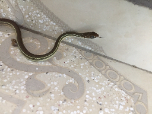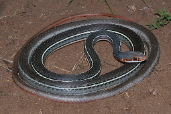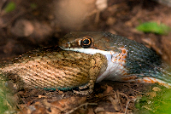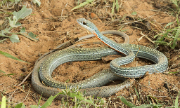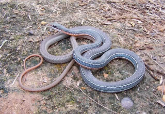Schott's Whipsnake (Masticophis schotti)
Description: Ground color of this long (to 5+ feet), slender, alert, and agile brushland snake is gray to blue-gray. It has 4 lengthwise stripes, 2 dorsolaterally and 2 laterally. Several rows of dorsal scales between the 2 upper stripes have an almost hidden cream spot on the anterior (attached) edge. The throat is white with orange spotting. The sides of the throat are orange. The belly is multicolored—off-white anteriorly, blue-gray posteriorly, and red-orange on the underside of the tail. This snake is an agile climber and may often be seen basking while elevated in the branches of a shrub. Scales smooth in 15 rows. Oviparous. Hatchlings look much like adults. It has 4 lengthwise stripes, 2 dorsolaterally and 2 laterally. Several rows of dorsal scales between the 2 upper stripes have an almost hidden cream spot on the anterior (attached) edge.
Habitat: The species' habitats include tropical dry forest, semi-deciduous forest, shrublands, grasslands, canyons, woodlands of pine/juniper/oak, rocky stream courses, and pond edges. In Texas, this snake occurs in savanna (mesquite-live oak; dry, rocky, and often sandy areas) and Tamaulipan thorn woodland; it is often associated with streambeds and ponds. Microhabitats are terrestrial and arboreal. It retreats underground or into deep crevices in cold weather.
Range: This species' range extends from the Balcones Escarpment of central Texas south to the Gulf Coastal Plain of Texas in the United States
Found in these States:
TX
Diet: Young eat mainly lizards; adults eat mainly lizards and small mammals; also eats insects and small birds.
Reproduction: Eggs may be laid in abandoned small mammal burrows.
Status: Listed as Least Concern in view of the wide range, and relatively stable extent of occurrence, area of occupancy, number of subpopulations, and population size.
»» Kingdom: Animalia - Animals
»» Phylum: Chordata - Chordates
»» Subphylum: Vertebrata - Vertebrates
»» Class: Reptilia - Reptiles
»» Order: Squamata - Scaled Reptiles
»» Suborder: Serpentes
»» Superfamily: Colubroidea
»» Family: Colubridae - Colubrids
»» Genus: Masticophis
»» Species: Masticophis schotti - Schott's Whipsnake
This article uses material from the Wikipedia article "Masticophis schotti", which is released under the Creative Commons Attribution-Share-Alike License 3.0. Content may have been omitted from the original, but no content has been changed or extended.
|


